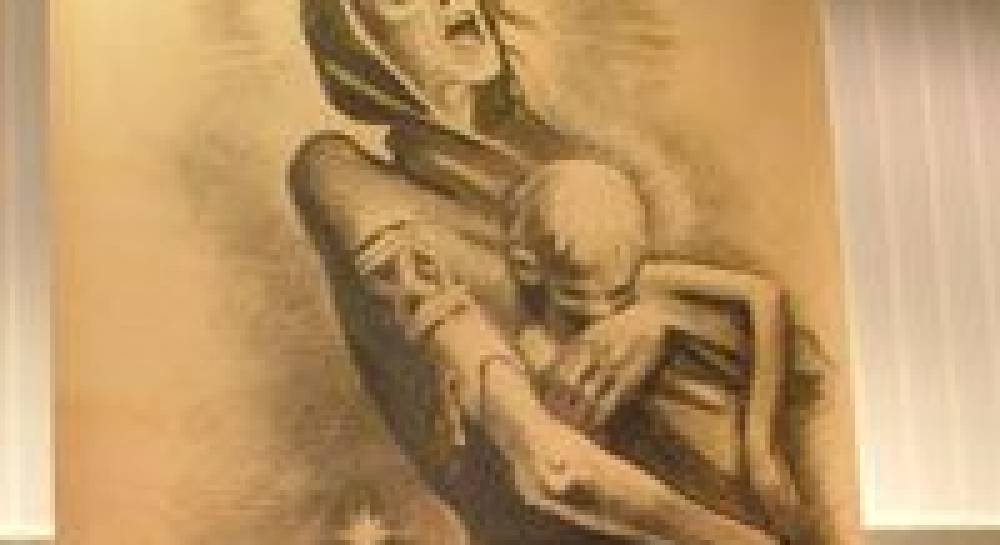
"Holodomor: Through the Eyes of Ukrainian Artists" collection
Almost no photographs existed that could be documented... In 1997 I began a search to find any artworks about Soviet crimes...The first Holodomor artworks I found were 15 posters...
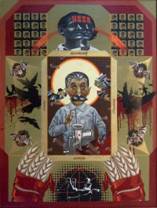 |
| Gods. 2nd Part - Glory To Great Stalin. АмenMykola Pavlusenko, Kyiv, Ukraine |
The news media and the artistic community are normally the first two major segments of a society to tell and show their own people and the world about such crimes against humanity.
Of course in the Soviet Union the news media and artistic community were totally repressed in terms of writing about or creating artwork about the Holodomor. It was not until late 1998 that the silence was finally broken in Ukraine.
In 1997 I started having discussions with Dr. James Mace, noted Holodomor researcher and scholar, about the Holodomor and what could be done to tell more people about it, to inform the world about the human suffering imposed against Ukrainians under Stalin. We both knew it was important to have the best scholarship and research but it is also important to show such human suffering visually.
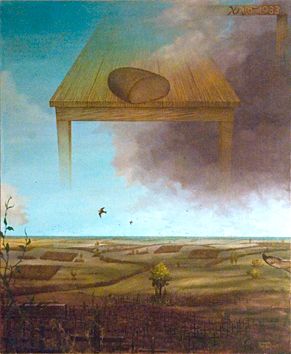 |
| Bread of the Year 33Yurko Kokh, Olha Pohribna-Kokh, Lviv, Ukraine |
Only around 20 photographs taken in Kharkiv have been documented. Materials
Jim and I also discussed the arts community in Ukraine and how so many of them were murdered, sent to the gulag or severely repressed during the Soviet era. The fear of creating any art, music, literature, etc. related to the crimes of the Soviet Union was strong, real and very effective in limiting the arts community. Jim mentioned that even still in 1997 most artists in Ukraine would not deal with such negative and controversial subjects.
So in late 1997 I began a search in Ukraine to find any artworks about the Holodomor that existed and to find artists who would be willing, out of their family memory and artistic souls, to deal with the Holodomor and other Soviet crimes.
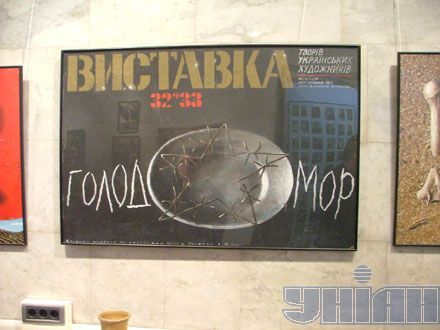 |
| Poster by Valeriy Viter |
The first Holodomor artworks I found in Kyiv were 15 outstanding posters created from 1989 to 1993 by poster and graphic artists who had be trained in Soviet times but were willing to break out of the restrictions of the past. Poster art is a great medium to use to depict political and governmental crimes. They had been collected by two young artists, Volodymyr and Irena Veshtak. These were the first artworks purchased for the collection.
The search continued and soon more poster art was found and also oil on canvas works and pencil on paper graphics. Finally a few artists were found, who because of what they had been told about their family members who died in the Holodomor, were willing over, time to consider creating new Holodomor related artworks.
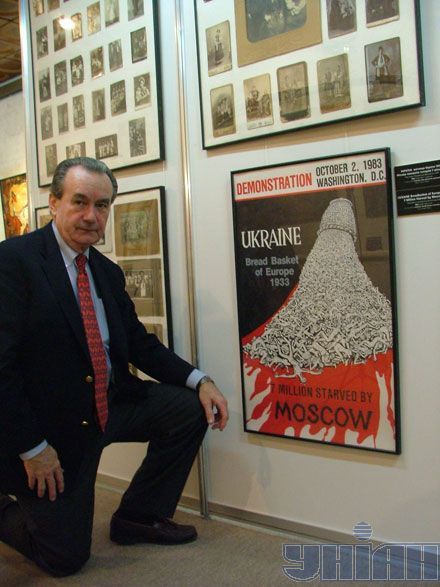 |
| Morgan Williams |
I found one graphics artist, Volodomyr Kutkin, who as a young art student in Kyiv, had been sent to the Gulag for five years. During the last 12 years of his life he created 120 pencil on paper artworks about his personal experiences during the Holodomor and in the Gulag. All of these original artworks are now in the collection.
Another graphics (linocut) artist who designed bookplates, Mykola Bondarenko, from the Sumy Oblast, in 1988 started to interview everyone in his local area that survived the Holodomor. He soon became very interested in their descriptions of the various items their parents tried to fix for them to eat in their fight for survival. From 1998 to 1993 he created one artwork for every item he was told someone tried to eat.
Mykola created over 60 such artworks and took them to Lenin`s hometown and displayed them in 1993. Mykola has continued to create Holodomor artworks and there are now over 80 of them. The collection contains copies of all of Mykola`s artwork.
In 1999 we found Nina Marchenko, an artist in Kyiv who grew up in the Poltava Oblast.
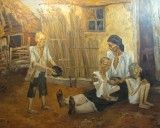 |
| Painting by Nina Marchenko |
Nina had been repressed by the Soviets as her interest was in painting large Soviet Socialist Realism Monumental artworks that showed the trials and tribulations of Soviet women. She did not want to create artworks than only showed `Glory to the Soviet Union."
Nina said she really wanted to create some artworks in the Soviet style to show what happened to women during the Holodomor. From 1999 to 2001 Nina created four large outstanding Soviet Socialist Realism Monumental artworks about suffering and death in 1932-33. I call these artworks, `the art works that never were.`
Artworks that were never allowed under the Soviets. These are the only four such artworks I know about and they held in the collection "Holodomor: Through The Eyes of Ukrainian Artists."
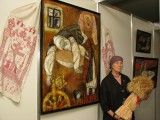 |
| Vira Kuleba |
Vira told me she had painted three artworks already about what happened to her family during the Holodomor. Since then Vira has created three more such artworks. One can easily tell when seeing them that they came from Vira`s strong feelings, her passion, her love for Ukraine, her very soul.
The search for artwork and to encourage artists in Ukraine to deal with the history of Ukraine continues to this day. The Holodomor: Through The Eyes of Ukrainians Artists" collection now contains over 350 original artworks. All of the artworks are in Ukraine. We want to thank all those who have donated funds to the collection so that additional artworks can be purchased and to assist in setting up exhibitions. All funds are donated through the Ukrainian Federation of America in Philadelphia.
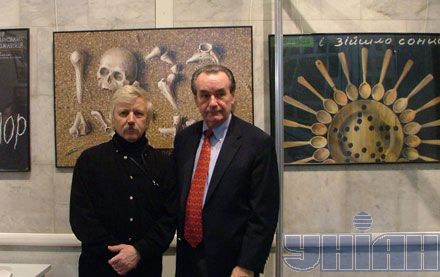 |
| Morgan Williams and artist Valeriy Viter |
Our first Holodomor artwork exhibition took place at the Teachers House in Kyiv in November of 2000. Since then several more exhibitions at the Ukrainian House have been held in Ukraine. The Ministry of Culture used the artwork in exhibitions around Ukraine in 2006 and 2007. Most of the collection was on display at the Holodomor 75th Commemoration Exhibition at the Ukrainian House in Kyiv in November, 2008.
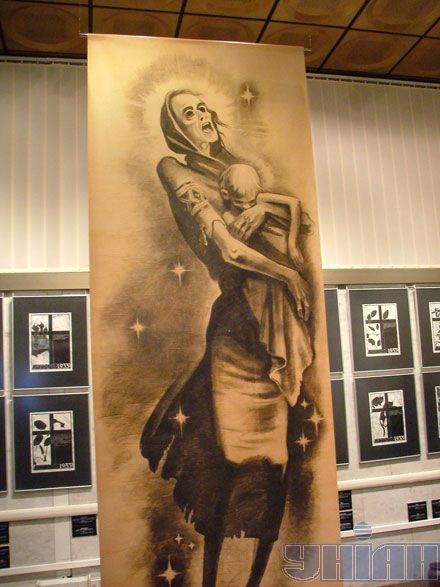 |
| Picture by Victor Cymbal |
The collection`s artworks are available to use and to display. We are now working with museums, libraries, universities, authors, teachers, and others who want to use copies of the artworks in their work. Those who are interested in the collection and possibly using the artworks should contact me at morganw@patriot.net We welcome those who wish to use the artworks in the collection to tell the world about the Holodomor.
By Mr. E. Morgan Williams, Director
Government Affairs, Washington Office
SigmaBleyzer Private Equity Investment GroupPresident/CEO, U.S.-Ukraine Business Council (USUBC)Publisher & Editor, Action Ukraine Report (AUR)
1701 K Street, NW, Suite 903, Washington, D.C. 20006
Mobile in Kyiv: 380 50 689 2874

